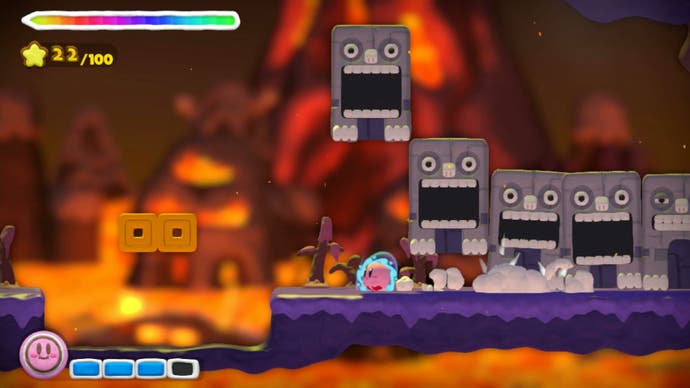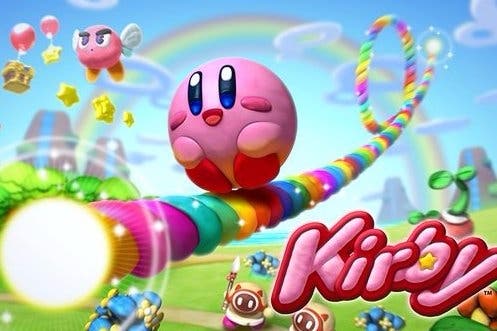Kirby and the Rainbow Curse review
Kicked to the Kirby.
If Mario is Nintendo's McCartney, then perhaps Kirby is its Harrison, the quiet, unassuming multi-instrumentalist responsible for some of the company's more offbeat moments (I've also heard it's Kirby that may have introduced Mario and co. to the magic of mushrooms). Since his inception at the hands of Masahiro Sakurai at HAL Laboratory, Kirby's lent himself to the further reaches of Nintendo's experiments, from the accelerometer powered Tilt 'n' Tumble to the slick velocity of Air Ride.
Kirby and the Rainbow Curse is the successor to one of the series' most successful offshoots, Canvas Curse, a 2005 Nintendo DS game that made use of the handheld's touchscreen and stylus. They're both features of the Wii U, of course, and have both been thoroughly implemented here, but Nintendo's current home console adds something else: a real sense of art, and of craft. Kirby and the Rainbow Curse is absolutely gorgeous.
Other games have gone for the Etsy aesthetic before, conjuring worlds that carry the aroma of PVA glue and that look like they've been hastily cut out by a craft-knife. Kirby and the Rainbow Curse goes beyond that, though, and its clay-sculpted characters and environment aren't worn lightly. The look might be familiar, but this isn't Clayfighter, or even The Neverhood - while Kirby isn't the first to be cast in clay, no other game has worn the soft thumb-marks and indentations of Play-Doh so proudly.
Kirby and the Rainbow Curse has been smart to really think about what such doughy texture brings to a game, doing away with the precision platforming of many of its predecessors and peers for something more playful, more malleable. This is equal parts pinball game and platformer, and there's something delightful about a game that draws upon the play school that has you furiously scribbling at the Game Pad like an inspired eight-year-old.
You don't have direct control over Kirby, and rather act as his guardian, guiding him through levels by sketching out ribbons of ink that help him navigate obstacles, and prodding him into a spin attack to deal with enemies. It's a curiously clumsy set-up at first, and Kirby's awkward kinetics as he bounces between walls are initially frustrating. You soon sync with the fact you don't have direct control, though, and start to enjoy the peculiar play space that HAL has given you.
It's a simpler game than its predecessor, Canvas Curse, with Kirby's ability to absorb the powers of enemies excised entirely, but it blossoms into a complex one. The pathways you make are drawn from a well of magic ink that's limited, running out after a few too many hasty swipes and taking a small amount of time to recharge.
Resource management is one thing, then, as is juggling Kirby through levels, a feat that requires more and more dexterity as you progress. By the end, as you're juggling multiple Kirbys with a frenzy of taps, swipes and sketches, it all comes into focus. By the time you're dabbling with the Challenge levels, unlocked as you progress through Rainbow Curse, a scalpel-like precision usurps the scrappiness that defines those early steps.
Kirby and the Rainbow Curse is a slight game - some 28 levels spread out across seven worlds that can be seen through in an afternoon - but it's generous with its ideas. Bosses hurl new kinks into the mechanics, while levels enjoy tinkering with the basic set-up; ideas are introduced and then tossed away without outstaying their welcome, a whole new twist ushered in in their place.

There's co-op, too, although it's a little strange in its execution, a second player taking charge of a Waddle-dee via a Wii remote that's controlled in a more traditional way. It speaks to a larger disconnect within Kirby and the Rainbow Curse, a game that delights even if it doesn't quite feel it's on the right platform. There's a lineage being continued here, not just from Canvas Curse but also other Nintendo touchscreen oddities such as Yoshi Touch & Go, and Rainbow Curse happily nestles in with such esteemed company. They're predominantly handheld games, though, and Rainbow Curse is a little too blasé about the main screen, forcing players to focus entirely on the GamePad.
It's a shame, as while the GamePad's screen is far from a disaster, so much time spent playing Rainbow Curse takes place with your eye trained away from the glorious world that HAL has created, the delicious assets rendered in sweet HD going to waste on that slightly smeared interface. There's not quite enough thought having gone into what being on a home console means, and the art aside, Rainbow Curse feels like too straightforward a transposition of an older format.
It's a minor blot, though, as elsewhere this lives up to the legacy of its predecessor, and takes it to new, interesting places. Kirby rarely gets a starring role in Nintendo's line-up, which is something of a shame, as the Rainbow Curse is another unconventional treat.



